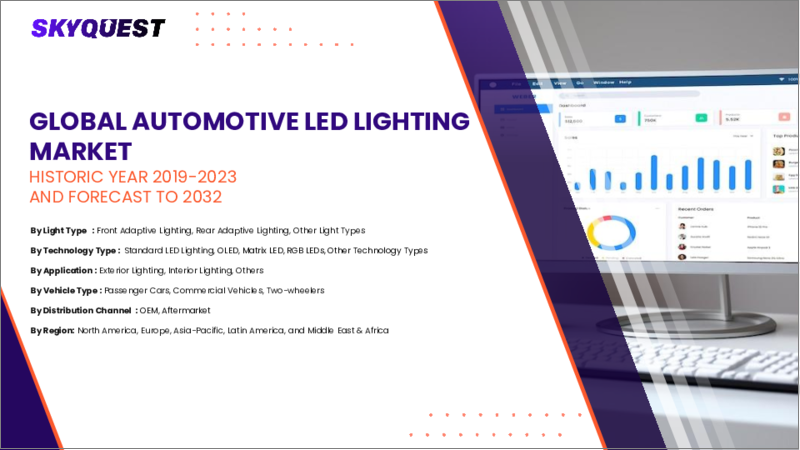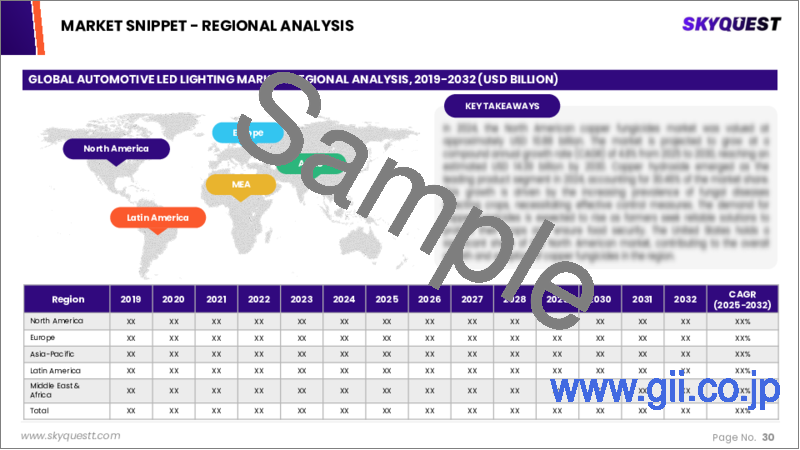|
|
市場調査レポート
商品コード
1603395
自動車用LED照明の市場規模、シェア、成長分析、技術タイプ別、車両タイプ別、用途別、地域別 - 産業予測、2024年~2031年Automotive LED Lighting Market Size, Share, Growth Analysis, By Technology type (OLED LED, MATRIX LED), By Vehicle Type( Passenger cars, Light Commercial Vehicles), By Type, By Application, By Region - Industry Forecast 2024-2031 |
||||||
|
|||||||
| 自動車用LED照明の市場規模、シェア、成長分析、技術タイプ別、車両タイプ別、用途別、地域別 - 産業予測、2024年~2031年 |
|
出版日: 2024年11月24日
発行: SkyQuest
ページ情報: 英文 223 Pages
納期: 3~5営業日
|
- 全表示
- 概要
- 目次
自動車用LED照明の世界市場規模は2022年に167億5,000万米ドルと評価され、2023年の181億9,000万米ドルから2031年には351億9,000万米ドルに成長し、予測期間(2024-2031年)のCAGRは8.6%で成長する見通しです。
世界の自動車用LED照明市場は、技術革新の収束、エネルギー効率の高い照明ソリューションに対する消費者の意識の高まり、自動車分野の拡大に後押しされ、最近大きな成長を遂げています。自動車メーカーが安全性、効率性、デザインをますます重視するようになるにつれ、LED照明は自動車の内装および外装の両方で好ましい選択肢となっています。この市場を牽引する主な要因は、エネルギー効率の高い照明ソリューションに対する需要の急増です。LED技術は、優れた明るさ、長寿命、エネルギー消費の削減を実現することで、白熱電球やハロゲン電球といった従来の代替照明よりも優れています。これは、世界の持続可能性イニシアティブに合致するだけでなく、自動車の燃費効率重視の高まりにも対応しています。利害関係者は、自動車の性能と美観を向上させる上で高度な照明ソリューションが重要な役割を果たすことを認識しており、これらの要素が組み合わさることで、自動車用LED照明市場は継続的な拡大が見込まれます。
目次
イントロダクション
- 調査の目的
- 調査範囲
- 定義
調査手法
- 情報調達
- 二次データと一次データの方法
- 市場規模予測
- 市場の前提条件と制限
エグゼクティブサマリー
- 世界市場の見通し
- 供給と需要の動向分析
- セグメント別機会分析
市場力学と見通し
- 市場概要
- 市場規模
- 市場力学
- 促進要因と機会
- 抑制要因と課題
- ポーター分析と影響
- 競争企業間の敵対関係
- 代替品の脅威
- 買い手の交渉力
- 新規参入業者の脅威
- 供給企業の交渉力
主な市場の考察
- 重要成功要因
- 競合の程度
- 主な投資機会
- 市場エコシステム
- 技術の進歩
- 規制情勢
- 特許分析
- バリューチェーン分析
- ケーススタディ分析
- 顧客と購買基準の分析
- PESTEL分析
- マクロ経済指標
- 貿易分析
- スタートアップ分析
- 市場の魅力指数
- 原材料の分析
- サプライチェーン分析
- 価格分析
自動車用LED照明の市場規模:技術タイプ別& CAGR(2024-2031)
- 有機EL
- マトリックスLED
自動車用LED照明の市場規模:用途別& CAGR(2024-2031)
- フロント照明
- リア照明
- サイド照明
- インテリア照明
自動車用LED照明の市場規模:車両タイプ別& CAGR(2024-2031)
- 乗用車
- 小型商用車
- トラック
- バス
- 二輪車
自動車用LED照明の市場規模:タイプ別& CAGR(2024-2031)
- フロントアダプティブライティング
- 自動オン/オフ
- ベンディング/コーナリングライト
- ハイビームアシスト
- ヘッドライトレベリング
- リアアダプティブライティング
- アンビエント照明
自動車用LED照明の市場規模:地域別& CAGR(2024-2031)
- 北米
- 米国
- カナダ
- 欧州
- 英国
- ドイツ
- スペイン
- フランス
- イタリア
- その他欧州地域
- アジア太平洋
- 中国
- インド
- 日本
- 韓国
- その他アジア太平洋地域
- ラテンアメリカ
- ブラジル
- その他ラテンアメリカ地域
- 中東およびアフリカ
- GCC諸国
- 南アフリカ
- その他中東・アフリカ
競合情報
- 上位5社の比較
- 主要企業の市場ポジショニング(2023年)
- 主な市場企業が採用した戦略
- 市場の最近の動向
- 企業の市場シェア分析(2023年)
- 主要企業の企業プロファイル
- 会社概要
- 製品ポートフォリオ分析
- セグメント別シェア分析
- 収益の前年比比較(2021-2023)
主要企業プロファイル
- Valeo
- Koninklijke Philips N.V.
- Robert Bosch GmbH
- Stanley Electric Co., Ltd.
- Hyundai Mobis
- Magneti Marelli Holdings Co., Ltd.
- NXP Semiconductors
- Denso Corporation
- APTiV PLC
- Koito Manufacturing Co., Ltd.
- Federal-Mogul Corporation(Tenneco Inc.)
- Grupo Antolin
- Varroc Group
- Lumax Industries Ltd.
- Nichia Corporation
結論と推奨事項
Global Automotive LED Lighting Market size was valued at USD 16.75 billion in 2022 and is poised to grow from USD 18.19 billion in 2023 to USD 35.19 billion by 2031, growing at a CAGR of 8.6% during the forecast period (2024-2031).
The global Automotive LED Lighting Market has experienced significant growth recently, fueled by a convergence of technological innovations, heightened consumer awareness regarding energy-efficient lighting solutions, and the expanding automotive sector. As manufacturers increasingly emphasize safety, efficiency, and design, LED lighting has become the preferred option for both interior and exterior automotive applications. A major factor driving this market is the surging demand for energy-efficient lighting solutions. LED technology outperforms traditional lighting alternatives, such as incandescent and halogen bulbs, by delivering superior brightness, extended lifespan, and reduced energy consumption. This not only aligns with global sustainability initiatives but also meets the growing focus on fuel efficiency in vehicles. The combination of these elements positions the Automotive LED Lighting Market for continued expansion, as stakeholders recognize the crucial role of advanced lighting solutions in enhancing vehicle performance and aesthetics.
Top-down and bottom-up approaches were used to estimate and validate the size of the Global Automotive Led Lighting market and to estimate the size of various other dependent submarkets. The research methodology used to estimate the market size includes the following details: The key players in the market were identified through secondary research, and their market shares in the respective regions were determined through primary and secondary research. This entire procedure includes the study of the annual and financial reports of the top market players and extensive interviews for key insights from industry leaders such as CEOs, VPs, directors, and marketing executives. All percentage shares split, and breakdowns were determined using secondary sources and verified through Primary sources. All possible parameters that affect the markets covered in this research study have been accounted for, viewed in extensive detail, verified through primary research, and analyzed to get the final quantitative and qualitative data.
Global Automotive Led Lighting Market Segmental Analysis
Global Automotive LED Lighting Market is segmented by Technology type, by application, by Vehicle Type, by type and by Region. Based on Technology Type , the market is segmented into OLED LED, Matrix LED. Based on application, the market is segmented into Front Lighting, Rear Lighting, Side Lighting, and Interior Lighting. Based on Vehicle Type, the market is segmented into Passenger cars, Light Commercial Vehicles, Trucks, Buses, and Two-wheels. Based on Type, the market is segmented into Front Adaptive Lighting (Auto On/Off, Bending/Cornering Lights, High Beam Assists, Headlight Levelling), Rear Adaptive Lighting, and Ambient Lighting. Based on region, the market is segmented into North America, Europe, Asia Pacific, Latin America and Middle East & and Africa.
Driver of the Global Automotive Led Lighting Market
The Global Automotive LED Lighting market is significantly driven by the continuous advancement of LED technology, which is essential in transforming automotive lighting solutions. Innovations in LED fixtures provide manufacturers with groundbreaking options that optimize performance, energy efficiency, and durability. Furthermore, the implementation of stringent safety regulations worldwide serves as a substantial catalyst, urging automotive producers to adopt advanced lighting technologies, particularly LEDs, to improve vehicle safety standards. As a result, the integration of sophisticated LED lighting systems not only enhances the aesthetic appeal of vehicles but also ensures compliance with safety requirements, solidifying its importance in the automotive industry.
Restraints in the Global Automotive Led Lighting Market
One significant constraint in the Global Automotive LED Lighting market is the high upfront cost associated with LED technology. The substantial initial investment required for integrating LED lighting solutions into vehicles can deter both manufacturers and consumers, limiting widespread adoption. Furthermore, the intricate nature of LED systems presents challenges related to maintenance and repair, which can further elevate the overall cost of ownership. This financial barrier can restrict the growth of the market, as stakeholders may be reluctant to invest in a technology that requires considerable resources at the outset, even if it offers long-term benefits and energy efficiency.
Market Trends of the Global Automotive Led Lighting Market
The Global Automotive LED Lighting market is witnessing a significant trend towards the integration of advanced technologies within LED systems, leading to enhanced safety and user experience. Automotive manufacturers are increasingly adopting features such as adaptive lighting, dynamic turn signals, and intelligent lighting control systems, which not only improve functionality but also cater to evolving consumer preferences. Concurrently, there is an intensified focus on energy efficiency and sustainability, as LED technology aligns seamlessly with the automotive sector's commitment to environmentally friendly practices. This convergence of innovation and sustainability positions the market for robust growth as it adapts to modern consumer and regulatory demands.
Table of Contents
Introduction
- Objectives of the Study
- Scope of the Report
- Definitions
Research Methodology
- Information Procurement
- Secondary & Primary Data Methods
- Market Size Estimation
- Market Assumptions & Limitations
Executive Summary
- Global Market Outlook
- Supply & Demand Trend Analysis
- Segmental Opportunity Analysis
Market Dynamics & Outlook
- Market Overview
- Market Size
- Market Dynamics
- Driver & Opportunities
- Restraints & Challenges
- Porters Analysis & Impact
- Competitive rivalry
- Threat of substitute
- Bargaining power of buyers
- Threat of new entrants
- Bargaining power of suppliers
Key Market Insights
- Key Success Factors
- Degree of Competition
- Top Investment Pockets
- Market Ecosystem
- Technological Advancement
- Regulatory Landscape
- Patent Analysis
- Value Chain Analysis
- Case Study Analysis
- Customer & Buying Criteria Analysis
- PESTEL Analysis
- Macro-Economic Indicators
- Trade Analysis
- Startup Analysis
- Market Attractiveness Index
- Raw Material Analysis
- Supply Chain Analysis
- Pricing Analysis
Global Automotive LED Lighting Market Size by Technology Type & CAGR (2024-2031)
- OLED LED
- Matrix LED
Global Automotive LED Lighting Market Size by Application & CAGR (2024-2031)
- Front Lighting
- Rear Lighting
- Side Lighting
- Interior Lighting
Global Automotive LED Lighting Market Size by Vehicle Type & CAGR (2024-2031)
- Passenger cars
- Light Commercial Vehicles
- Trucks
- Buses
- Two-wheels
Global Automotive LED Lighting Market Size by Type & CAGR (2024-2031)
- Front Adaptive Lighting,
- Auto On/Off
- Bending/Cornering Lights
- High Beam Assists
- Headlight Levelling
- Rear Adaptive Lighting
- Ambient Lighting
Global Automotive LED Lighting Market Size by Region & CAGR (2024-2031)
- North America, (by Technology type, by application, by Vehicle Type, by type)
- US
- Canada
- Europe, (by Technology type, by application, by Vehicle Type, by type)
- UK
- Germany
- Spain
- France
- Italy
- Rest of Europe
- Asia-Pacific, (by Technology type, by application, by Vehicle Type, by type)
- China
- India
- Japan
- South Korea
- Rest of Asia Pacific
- Latin America, (by Technology type, by application, by Vehicle Type, by type)
- Brazil
- Rest of Latin America
- Middle East & Africa, (by Technology type, by application, by Vehicle Type, by type)
- GCC Countries
- South Africa
- Rest of Middle East & Africa
Competitive Intelligence
- Top 5 Player Comparison
- Market Positioning of Key Players, 2023
- Strategies Adopted by Key Market Players
- Recent Developments in the Market
- Company Market Share Analysis, 2023
- Company Profiles of All Key Players
- Company Details
- Product Portfolio Analysis
- Company's Segmental Share Analysis
- Revenue Y-O-Y Comparison (2021-2023)
Key Company Profiles
- Valeo
- Company Overview
- Business Segment Overview
- Financial Updates
- Key Developments
- Koninklijke Philips N.V.
- Company Overview
- Business Segment Overview
- Financial Updates
- Key Developments
- Robert Bosch GmbH
- Company Overview
- Business Segment Overview
- Financial Updates
- Key Developments
- Stanley Electric Co., Ltd.
- Company Overview
- Business Segment Overview
- Financial Updates
- Key Developments
- Hyundai Mobis
- Company Overview
- Business Segment Overview
- Financial Updates
- Key Developments
- Magneti Marelli Holdings Co., Ltd.
- Company Overview
- Business Segment Overview
- Financial Updates
- Key Developments
- NXP Semiconductors
- Company Overview
- Business Segment Overview
- Financial Updates
- Key Developments
- Denso Corporation
- Company Overview
- Business Segment Overview
- Financial Updates
- Key Developments
- APTiV PLC
- Company Overview
- Business Segment Overview
- Financial Updates
- Key Developments
- Koito Manufacturing Co., Ltd.
- Company Overview
- Business Segment Overview
- Financial Updates
- Key Developments
- Federal-Mogul Corporation (Tenneco Inc.)
- Company Overview
- Business Segment Overview
- Financial Updates
- Key Developments
- Grupo Antolin
- Company Overview
- Business Segment Overview
- Financial Updates
- Key Developments
- Varroc Group
- Company Overview
- Business Segment Overview
- Financial Updates
- Key Developments
- Lumax Industries Ltd.
- Company Overview
- Business Segment Overview
- Financial Updates
- Key Developments
- Nichia Corporation
- Company Overview
- Business Segment Overview
- Financial Updates
- Key Developments





